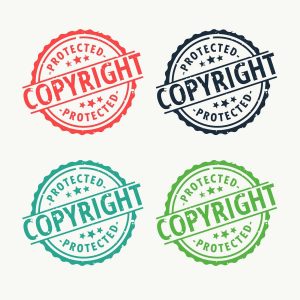
Have you ever shared a photo of someone? Perhaps copied a sentence or two from someone's text? Posted certain content from the Internet on your social networks? Used pre-made solutions in your campaign? Does all of this make you an intellectual property thief? Do you protect YOUR content from being copied?
Most people have stolen something at least once, whether accidentally or intentionally. When we were kids, we may have left the lollipop store on purpose, but we didn't know what we were doing.
If an adult, in full consciousness and common sense, leaves the store with an item that they intentionally did not pay for, it is very likely that this act would be socially labeled as stealing.
However, if two portals that normally deal with different topics publish an article with the same title and very similar content one after the other, it is very likely that this act will be characterized as inspiration.
If you rely on your blog for traffic and conversions, you're probably interested in measuring and improving the effectiveness of that strategy. But if you're just getting started with blogging, the idea of protecting your intellectual property may be new to you.
Content theft is when you use someone else's content as your own. This is a common problem that can ruin your reputation. Not to mention, it can be a costly mistake.
Content theft is more common than you think. It's also one of the most overlooked. Millions of dollars have been lost to content theft and copyright infringement.
According to Statista.com, 69% of internet users have had their content stolen. That's about 20% of the entire world's population!
With the advent and popularization of social media and the availability of various content, the pitfalls of copyright infringement are all around us. There are a few examples that we see every day, but we also break them ourselves even though we are not even aware of it.
Let's take a look at what the process looks like in the real world and happens every day with these three everyday situations.
On your favorite social network, while scrolling forever, you came across a photo that you really liked. You decided it would be an extremely good idea to share that photo in your Story. How you go about doing that?
You took a screenshot of the photo, cropped off all the less important parts, and uploaded the photo as such to your Story. Chances are you broke the law by doing this. Because if it's an author photo, it's almost certain that you fell into a trap and broke the law without realizing it.
If for some reason you plan to share someone else's content, share it directly from your profile. This way you automatically share the link to the source, i.e. the content author. Also, the bottom right corner of the photo that contains the author's name will not be cropped.
Here's some advice on how to protect your images from theft:
- Copyright your images
- Implement website policies
- Adding the DMCA logo to your website
- Editing the EXIF data of your images
- Uploading low resolution images
- Watermarking your images
- Disable hotlinking
- Disabling the right-click function
Similar rules apply to videos as well: Copyright your videos, implement website policies, don't forget to put the DMCA logo on your website, always watermark your videos, and disable the right-click feature.
In the online world, if your company produces online courses, follow these four rules:
- make them accessible, but not too accessible
- add copyright notice
- register important parts of the content
- prepare course contract
You are writing. You write every day. You read an article that fits extremely well with the concept of your next article. What do you do?
Of course you copy the sentence, two, five, the whole paragraph and incorporate it nicely into your text as it suits you. The portal you downloaded the article from has fewer followers than you anyway, no one will notice.
There's a great thing about the world of digital writing, and it's called a link. No one is forbidding you, me or anyone else from using someone else's work, but it is always necessary to cite the source, the author.
Top 3 tips to avoid plagiarism
The first step to protecting intellectual work is to accurately attribute the material. We can't prevent plagiarism, but it's up to us how much energy we want to invest to make sure that law and justice are on the same page.
Were those sentences copied from somewhere? I don't know. Do you know? You probably don't know either, and you haven't even paid attention to the fact that they might have been copied from somewhere.
In today's dynamic society, and especially in the context of the media, intellectual property protection is extremely vulnerable to everyday infringement, whether intentional or accidental. Why, in fact. 
The product of the intellectual thought process is often difficult to define in the minds of people, especially those who are not creators, as a thing with physical characteristics that can be subject to certain legal sanctions.
Already the legal mechanism of "fighting" intellectual property theft becomes complicated, so that an aggrieved person may lose more than he gains in the process itself. Much remains unresolved in the context of legal protections and services that help creators protect intellectual property.
In contrast, intellectual property thefts are commonplace and frequent. With the exception of the everyday, say accidental, thefts that occur in Situation 1, it is often the idea itself that is stolen.
So here are some good ways to protect textual content from theft:
1. implement site policies
2. add the DMCA logo to your site
3. disable text selection on your blog
4. disable right-click
You see, there are a number of cases where larger companies post a contest for, say, a designer product. A number of young, aspiring and talented people apply for the contest. The selection process begins, and when it begins, part of the process is product design.
At this point, the narrow group of selected candidates who have come to this part of the selection process to continue the process solve a particular design problem that was proposed to them by a potential company.
They all completed the task and turned their idea into a proposed solution, which they presented as such and of course proposed to a potential employer with all the relevant information. They did all this with one goal in mind, to get a specific job.
Unfortunately, none of the applicants met all the conditions and, unfortunately, another applicant was accepted who met the better conditions, i.e. whose solution was more appropriate and better. However, what the applicants do not know is that perhaps none of the applicants were accepted.
In this example, we have seen that the company has been given a polished idea for a product that needs to be taken all the way to the end, the designers have invested time, effort and other resources into the idea and conceptualizing the idea, but they have not created a product, they have given a potential employer a solution to a problem. Businesses may use some ideas on social media or further.
How to prevent plagiarism on social media:
1. put your name on it
2. tag it with Copyright Statement
3. monitor and report it to Social Media platforms
4. complain to administrators on social media
You may get the thought after reading this article that someone has already stolen or copied your content. How do you find out if that's the case? Invest in a few good tools:
1. Google Image Reverse Search is a wonderful tool to find other sites that have copied images from your site. 
2. TinEye Reverse Image Search is a fantastic tool to find other websites that have used images from your website.
3. Plagiarism Checker X is a great and affordable tool to find other websites that have copied and used content from your website.
You can also try Copyscape, DupliChecker, Grammarly Plagiarism Checker, Online metadata and EXIF viewer,... you can try them out.
Copied content can really hurt your search engine rankings. Google is very strict when it comes to copying content. If you think your content has been copied elsewhere, you can notify Google and it will take action. You can always try to track down the owner, report the content theft, notify the hosting service provider, ask Google to remove the stolen content from search results and you have all the rights to take legal action.
Be careful and never do to another what you don't want to happen to you!